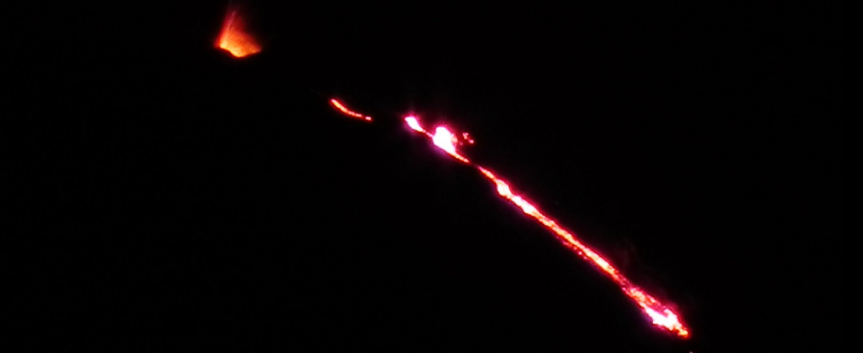Increase in activity at Guatemala’s Pacaya volcano

A new lava flow has become active at Guatemala's Pacaya volcano over the past couple of days. This new cycle of lava flow activity is expected to continue in the coming days.
The lava flow began to erupt from a fissure inside the large breach on the NE flank of MacKenney cone since around February 9, 2017. The flow is directed toward the Cerro Chino crater, INSIVUMEH said in a special bulletin published February 14.
Strombolian activity continues at the new cinder cone that has been gradually filling the summit crater over the past two years.
So far, it is estimated that the flow has a width of 20 meters (65 feet) and a length of approximately 50 m (164 feet). The length has varied since there are periods in which production of material decreases or increases.
This new cycle of lava flow activity is expected to continue in the coming days, generating moderate to strong explosions up to 300 m (1 000 feet) from the crater.
Vista desde San Miguel Petapa de la actividad del volcán de Pacaya. #RT pic.twitter.com/crJi58hMWV
— Noticias del Sur (@NoticiasSurGT) February 14, 2017
Actividad estromboliana del Volcán #Pacaya en Guatemala, crece cono cinerítico y aumentan flujos de lava
Foto: @William_Chigna pic.twitter.com/26CBJcbdhS— Geól. Sergio Almazán (@chematierra) February 14, 2017
Geological summary
Eruptions from Pacaya, one of Guatemala's most active volcanoes, are frequently visible from Guatemala City, the nation's capital. This complex basaltic volcano was constructed just outside the southern topographic rim of the 14 x 16 km Pleistocene Amatitlán caldera. A cluster of dacitic lava domes occupies the southern caldera floor. The post-caldera Pacaya massif includes the ancestral Pacaya Viejo and Cerro Grande stratovolcanoes and the currently active Mackenney stratovolcano.
The collapse of Pacaya Viejo between 600 and 1500 years ago produced a debris-avalanche deposit that extends 25 km onto the Pacific coastal plain and left an arcuate somma rim inside which the modern Pacaya volcano (Mackenney cone) grew. A subsidiary crater, Cerro Chino, was constructed on the NW somma rim and was last active in the 19th century. During the past several decades, activity has consisted of frequent strombolian eruptions with intermittent lava flow extrusion that has partially filled in the caldera moat and armored the flanks of Mackenney cone, punctuated by occasional larger explosive eruptions that partially destroy the summit of the growing young stratovolcano. (GVP)
Featured image: New lava flow at Guatemala's Pacaya volcano, February 14, 2017. Credit: Noticias del Sur

Commenting rules and guidelines
We value the thoughts and opinions of our readers and welcome healthy discussions on our website. In order to maintain a respectful and positive community, we ask that all commenters follow these rules:
We reserve the right to remove any comments that violate these rules. By commenting on our website, you agree to abide by these guidelines. Thank you for helping to create a positive and welcoming environment for all.